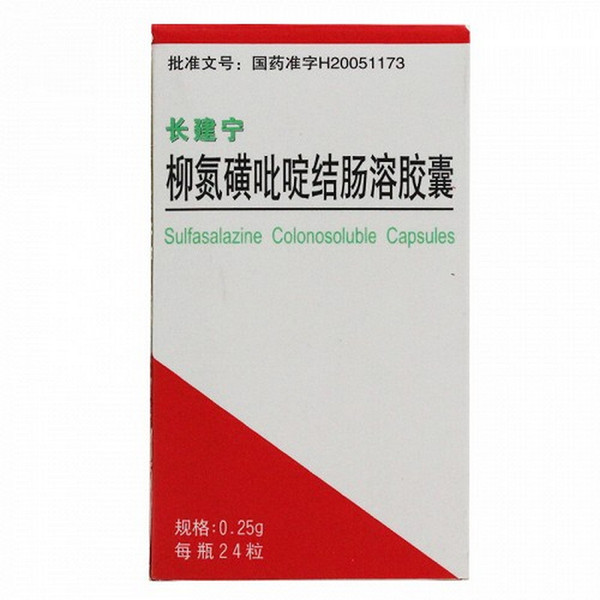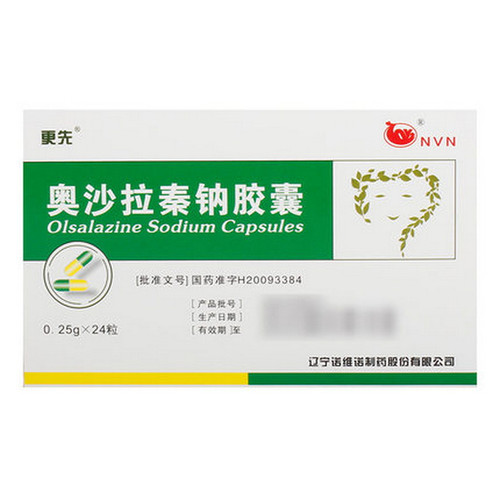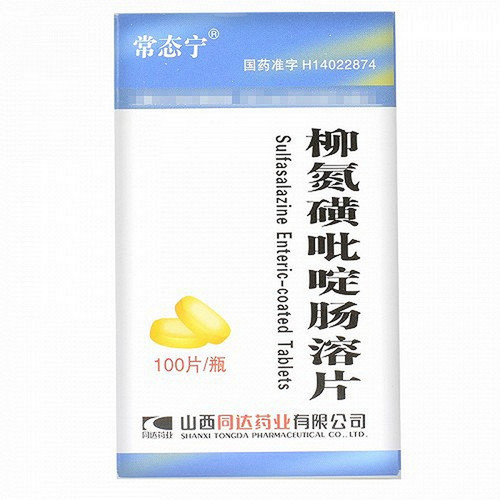Product Overview
[Drug Name]
Generic Name: Sulfasalazine Colonosoluble Capsules
Trade Name: Changjianning Sulfasalazine Colonosoluble Capsules 0.25g*24 Capsules
Pinyin Code: ChangJianNing LiuDanHuangZuoZuoJieChangRongJiaoNang 0.25g*24Li
[Main Ingredients]
The main ingredient of this product is sulfasalazine. Its chemical name is 5-[p-(2-pyridylaminosulfonyl)phenyl]azosalicylic acid.
[Properties]
This product is a colon-coated capsule containing dark yellow to brown granules or powder.
[Indications/Main Functions]
For the treatment of mild to moderate ulcerative colitis and adjunctive treatment of severe ulcerative colitis. It is particularly suitable for gastrointestinal discomfort associated with sulfasalazine tablets (such as anorexia).
[Specifications]
0.25g*24 tablets
[Dosage and Administration]
1. Adults: 3-4g (12-16 tablets) orally daily, divided doses. Dosage intervals should not exceed 8 hours. To prevent gastrointestinal intolerance, start with a low dose of 1-2g (4-8 tablets) daily. If the dose exceeds 4g (16 tablets) daily, be aware of increased toxicity. 2. For severe attacks, take 1-2g (4-8 tablets) 3-4 times daily. It can be used in combination with steroids as an intensive treatment regimen. For mild and moderate attacks, take 1g (4 tablets) 3-4 times daily. 3. During remission: A maintenance dose is recommended to prevent symptom recurrence, generally 1g (4 tablets) 2-3 times daily. 4. Children: 40-60 mg per kg of body weight per day, divided into 3-6 doses. To prevent relapses, 20-30 mg per kg of body weight per day, divided into 3-6 doses. (Should be swallowed whole.)
[Adverse Reactions]
Severe attacks: 1-2 g (4-8 tablets) per dose, 3-4 times daily. Can be used in combination with steroids for intensive treatment. Mild and moderate attacks: 1 g (4 tablets) per dose, 3-4 times daily. During remission: A maintenance dose is recommended to prevent recurrence of symptoms, generally 1 g (4 tablets) per dose, 2-3 times daily. Children: 40-60 mg per kg of body weight per day, divided into 3-6 doses. To prevent relapses.
[Contraindications]
Sulfasalazine and its metabolites, sulfonamides, and salicylates are contraindicated; children under 2 years of age are contraindicated; and patients with intestinal obstruction, urinary tract obstruction, and hemoporphyria are contraindicated.
[Drug Interactions]
1. Concomitant use with urinary alkalinizing agents may increase the solubility of sulfonamides in alkaline urine, leading to increased excretion. 2. Para-aminobenzoic acid can displace sulfonamides for bacterial uptake, antagonizing the antibacterial effects of sulfonamides. Therefore, these two drugs should not be used together. 3. When used together with sulfonamides, the latter may displace the protein binding sites of these drugs or inhibit their metabolism, resulting in prolonged drug action or toxicity. Therefore, the dosage of these drugs should be adjusted when used together with sulfonamides or after sulfonamides. These drugs include oral anticoagulants, oral hypoglycemic agents, methotrexate, phenytoin sodium, and thiopental sodium.
[Precautions]
1. The most common adverse reactions are: nausea, anorexia, fever, erythema and pruritus, headache, and palpitations. 2. The following adverse reactions are rare and may be dose-related: Hematologic reactions: Red blood cell abnormalities (e.g., hemolytic anemia, macrocytosis), cyanosis; Gastrointestinal reactions: Stomach and abdominal pain; Central nervous system reactions: Dizziness, tinnitus; Renal reactions: Proteinuria, hematuria; Skin reactions: Yellowing of the skin; 3. The following reactions may not be dose-related: Hematologic reactions: Bone marrow suppression, such as with leukopenia, granulocytopenia, and thrombocytopenia; Digestive system reactions: Hepatitis, pancreatitis; Central nervous system reactions: Peripheral neuropathy, aseptic meningitis; Skin reactions: Rash, urticaria, erythema multiforme/Stevens-Johns
[Pediatric Use]
Not yet known.
[Pharmacology and Toxicology]
SASP is a product of 5-aminosalicylic acid and sulfapyridine bound together by an azo bond. After oral administration, it is cleaved into 5-aminosalicylic acid and sulfapyridine by azoreductase in the intestinal microbiome. 5-aminosalicylic acid is the main active ingredient of SASP, which can inhibit the synthesis of prostaglandins, thereby exerting antibacterial, anti-inflammatory and immunosuppressive effects, and can inhibit the acute attack of ulcerative colitis. SASP can also exert anti-rheumatoid arthritis and other effects through antibacterial, anti-inflammatory and immunosuppressive effects. (1) Antibacterial effect: SASP can inhibit intestinal flora, and intestinal bacterial infection may be related to the pathogenesis of spondyloarthritis. Although most patients with this disease do not have clinical symptoms of enteritis, intestinal mucosal inflammation can be seen under colonoscopy, and it changes with the progression of the disease. Studies have found that 67% of patients with rheumatoid arthritis have a large amount of Clostidum Perfringens hyphae or excessive α-toxin products in the intestine. When arthritis is relieved, intestinal inflammation often disappears, while intestinal inflammation often persists when joint lesions are active. The discovery of subclinical intestinal inflammation in spondyloarthritis provides a reasonable basis for the use of SASP treatment. (2) Anti-inflammatory effect: SASP exerts anti-inflammatory effects by promoting the release of adenosine at the inflammatory site. (3) Immunosuppressive effect: SASP has an inhibitory effect on a variety of inflammatory cells, and can significantly inhibit the chemotaxis of neutrophils and the myeloperoxidase activity of neutrophils, reduce the generation of oxygen free radicals, and accelerate the apoptosis of neutrophils.









